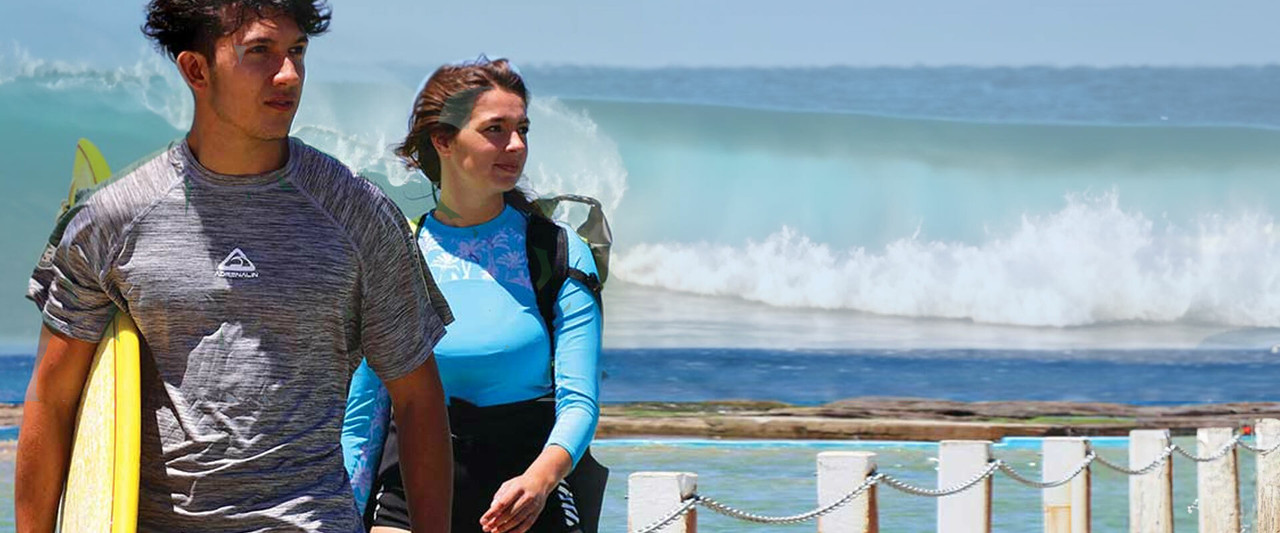A Tackle Shop Guide to Rash Vests & Tops
It’s easy to get confused by the term "rash vest." In our shop, it covers two completely different categories of gear: thin, sun-blocking tops for sun and stinger protection, and thick, insulated tops for warmth. This guide will break down the key differences so you can choose the right one for your needs.
A Note From Our Local Experts
"When most people think of a 'rashie', they think of a thin top for surfing. But for anglers, the game is different. I've spent too many pre-dawn winter mornings on the boat freezing my rear end off, and a standard fishing shirt just doesn't cut it. That's when I learned the value of a good thermal rash vest as a base layer—it's a massive difference-maker for staying warm.
On the flip side, a lightweight sun-safe rashie top is something I keep with me incase I want to head into the water for a dip after a long days fishing. It’s all about having the right style for the conditions."
- Ben Czulowski, Owner, Fishing Tackle Shop (Ocean Storm) | 20+ Years in Retail
A Guide to Rash Tops
The first step is to match the material to your mission. Are you trying to stay cool or stay warm?
✔
Lycra Rash Vests (Sun & Stinger Protection): These are your classic, lightweight "rashies." They are made from thin, quick-drying lycra/spandex material. Their job is not to keep you warm, but to provide excellent sun protection and often can act as a bit of a light barrier against jellyfish and sea lice. They're also ideal for surfing and bodyboarding to prevent rashes.
✔
Thermal Tops (For Warmth): This is a completely different piece of gear. A thermal rash top is made from materials like fleece-lined polypropylene or neoprene, and is designed to trap a thin layer of water (or air) against your skin, which your body then heats up. It's the perfect base layer for winter fishing, kayaking, or surfing to keep your core warm.
✔
Stinger Suits (Full Body Protection): For anglers wading or swimming in tropical waters in QLD or the NT, a stinger suit is a critical piece of safety gear. It's a full-body, lightweight lycra suit that provides head-to-toe protection from dangerous Irukandji and other jellyfish.
Pro-Tips for Your Rash Vest
- Fit is Everything: For both a sun rashie and a thermal top, a snug, "second skin" fit is essential. A loose-fitting top will trap excess water, bunch up under your clothes, and, in the case of a thermal top, will fail to trap heat against your body effectively.
- The "Rinse & Dry" Rule: After every use, always rinse your rash vest thoroughly in fresh water. Salt and chlorine are the enemies of lycra and will destroy the material's elasticity over time.
- Never Use a Hot Dryer: This is the fastest way to ruin a rash vest. The high heat will permanently damage the elastic fibres and make your top brittle and stretched-out. Always let it drip-dry in a shaded, well-ventilated area.
Frequently Asked Questions
What's the difference between a rash vest and a fishing shirt?
This is a common question. A rash vest is a skin-tight, "second skin" made of lycra or thermal material, designed as a base layer for in-water use or for warmth. A fishing shirt is a loose-fitting, vented, button-up or sublimated "over-shirt" designed for casting comfort and sun protection out of the water, like on a boat deck or beach.
Will a standard lycra rashie keep me warm?
No, and in some cases, it can make you colder. A standard rash vest has no insulating properties. When you get out of the water, a wet, wind-chilled rashie will draw heat away from your body. For warmth, you must choose a dedicated thermal top made from insulating materials like fleece-lined polypropylene.
How do I choose the right size?
A rash vest is designed to be a very snug, athletic fit. We generally recommend choosing your standard t-shirt size for a firm, "second skin" fit. If you prefer a slightly looser, more casual fit, you may want to go up one size.
How do I stop my rash vest from smelling?
The smell is caused by mildew and bacteria growing in the damp material. The best way to prevent it is to give it a thorough rinse in fresh water as soon as you get home. Don't leave it in a wet, bunched-up ball in your bag. Let it dry completely in a well-ventilated, shaded spot before storing it.



